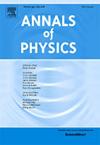Shadow of F(R)-Euler–Heisenberg black hole and constraints from EHT observations
IF 3
3区 物理与天体物理
Q2 PHYSICS, MULTIDISCIPLINARY
引用次数: 0
Abstract
This study investigates the optical properties of a static, spherically symmetric, electrically charged black hole in gravity, coupled with Euler–Heisenberg () nonlinear electrodynamics (NLED). By analyzing photon trajectories in this background, we demonstrate how the model parameters influence light propagation, leading to broader ranges for both lensed paths and photon rings. We identify parameter regions that allow for physically consistent black hole shadows, characterized by a photon sphere located outside the event horizon and a shadow forming beyond it. These viable regions expand with increasing electric charge and , highlighting the interplay between gravitational and electromagnetic effects. Constraining the model using Event Horizon Telescope (EHT) observations of M87*, we find that de Sitter (dS) black holes remain compatible with the data, whereas anti-de Sitter (AdS) solutions are disfavored under low charge and . Finally, our analysis of the energy emission rate shows that higher electric charge enhances black hole evaporation, while stronger NLED effects and larger values suppress it.
F(R)-欧拉-海森堡黑洞的阴影和EHT观测的约束
本文研究了f(R)引力下静态球对称带电黑洞的光学特性,并结合了欧拉-海森堡非线性电动力学(NLED)。通过分析这种背景下的光子轨迹,我们展示了模型参数如何影响光的传播,从而导致透镜路径和光子环的更宽范围。我们确定了允许物理上一致的黑洞阴影的参数区域,其特征是位于视界之外的光子球和在视界之外形成的阴影。这些可行区域随着电荷和fR0的增加而扩大,突出了引力和电磁效应之间的相互作用。利用事件视界望远镜(EHT)对M87*的观测约束模型,我们发现de Sitter (dS)黑洞与数据保持兼容,而反de Sitter (AdS)解在低电荷和fR0>;−1下不受欢迎。最后,我们对能量发射率的分析表明,更高的电荷会促进黑洞的蒸发,而更强的NLED效应和更大的fR0值会抑制黑洞的蒸发。
本文章由计算机程序翻译,如有差异,请以英文原文为准。
求助全文
约1分钟内获得全文
求助全文
来源期刊

Annals of Physics
物理-物理:综合
CiteScore
5.30
自引率
3.30%
发文量
211
审稿时长
47 days
期刊介绍:
Annals of Physics presents original work in all areas of basic theoretic physics research. Ideas are developed and fully explored, and thorough treatment is given to first principles and ultimate applications. Annals of Physics emphasizes clarity and intelligibility in the articles it publishes, thus making them as accessible as possible. Readers familiar with recent developments in the field are provided with sufficient detail and background to follow the arguments and understand their significance.
The Editors of the journal cover all fields of theoretical physics. Articles published in the journal are typically longer than 20 pages.
 求助内容:
求助内容: 应助结果提醒方式:
应助结果提醒方式:


